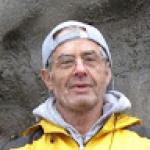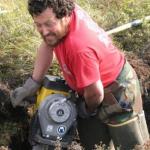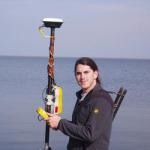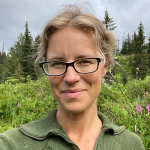The Transition Zone of Upper Permafrost: The Frontline for Permafrost Changes across Climate and Landscape Gradients
Permanently frozen soils, or permafrost, often contain large amounts of ground ice, which make it vulnerable to climate change and human activities. These soils are protected from melting by a surface layer which thaws in summer and refreezes in winter, and a near-surface layer, termed the transition zone. This transition zone, which develops through complex interactions between the environment and permafrost, controls permafrost resilience to ground surface subsidence (thermokarst). Expectations are that as the climate warms, deeper seasonal melting will impact this transition zone, and ecosystems and infrastructure (i.e., roads, airfields, and buildings) stability. The goals of this project are to evaluate the properties of the transition zone from the High Arctic to the southern border of the permafrost region and to understand processes of formation, degradation, and recovery of the transition zone in various climatic regions. The knowledge gained from this work will inform Arctic science and engineering. The project will support student training. The investigators will collaborate with government agencies and engineering companies whose work is impacted by permafrost ground subsidence issues.
In previous research, the investigators identified a zone in the upper profile of permafrost soils that is critical to permafrost stability, soil development, and geomorphic processes. However, how the thickness and cryostructures of this transition zone (TZ) vary across climate and landscape gradients, the rates of its formation during ecological succession, and how it contributes to permafrost vulnerability and resilience, is not well understood. What knowledge we have is in low Arctic tundra and can be misleading if applied to other bioclimatic regions. To address this gap in knowledge, our collaborative research with the University of Montreal will focus on the TZ across climatic regions and landscapes distributed along a north-south transect from barren polar deserts with continuous permafrost in Canada, to boreal forests in southern Alaska with sporadic permafrost. Our group will also monitor and experiment with mass and heat transfer processes between the active layer (AL) and the TZ to identify mechanisms controlling segregated ice formation.
Researchers on this project will assess physical principles and factors responsible for aggradation and degradation of ice-rich upper permafrost layers through extensive field studies at an array of sites representing a range of bioclimatic and landscape conditions characteristic of Arctic permafrost regions as well as analysis of available data. During 2019 through 2021, a team of researchers studied permafrost at numerous field sites: Tuktoyaktuk and Bylot Island in Canada; Utqiagvik (Barrow), Prudhoe Bay, Fairbanks area; along the Dalton (including Toolik) and Richardson Highways in Alaska; and at fly-in sites near Teshekpuk Lake, the Anaktuvuk River fire scars, and the Itkillik (Stinking Hills). Field work during each year had a duration of 30-50 days, except 2020, when, due to COVID-19 pandemic, our field work was reduced to two field studies: Vault Creek and Prudhoe Bay. In 2022, a team will work at Utqiagvik (Barrow), Point Lay, Teshekpuk Lake, Toolik, Anaktuvuk River Fire, and Prudhoe Bay. Note: M. Torre Jorgenson (Alaska Ecoscience) collaborates via a subaward issued by the University of Alaska Fairbanks (NSF funding).
Resources
Permafrost History and Vulnerability to Climate Change in Alaska
Permafrost History and Vulnerability to Climate Change in Alaska Alaska Institute for Climate & Energy (ALICE) Webinar, April 20, 2021
M. Torre Jorgenson, Alaska Ecoscience, Fairbanks, AK
Manual for Roads and Airfields Constructed on Permafrost
Billy Connor of the University of Alaska Fairbanks has published a manual for construction on permafrost he co-authored with Douglas J. Goering, Mikhail Kanevskiy, and Erin Trochim of UAF and Kevin L. Bjella of USACE CRERL and Robert McHattie of GZR Engineering, for the Alaska Department of Transportation and Public Safety (AKDOT&PF). The manual is titled "ROADS AND AIRFIELDS CONSTRUCTED ON PERMAFROST: A Synthesis of Practice" and is available through Scholarworks.
Roads and Airfields on Permafrost: A Synthesis of Practice
Billy Connor of the University of Alaska Fairbanks presents this webinar to accompany a manual he co-authored with other experts for the Alaska Department of Transportation and Public Safety.
Research Collaborator(s)
Publications
Bergstedt, H., B.M. Jones, K. Hinkel, L. Farquharson, B.V. Gaglioti, A.D. Parsekian, M. Kanevskiy, N. Ohara, Noriaki A.L. Breen, R.C. Rangel, G. Grosse, and I. Nitze, 2021: Remote Sensing-Based Statistical Approach for Defining Drained Lake Basins in a Continuous Permafrost Region, North Slope of Alaska, Remote Sensing, 13, https://doi.org/10.3390/rs13132539
Bergstedt, H., B.M. Jones, D. Walker, J. Peirce, A. Bartsch, G. Pointner, M. Kanevskiy, M. Raynolds, and M. Buchhorn, 2023: The spatial and temporal influence of infrastructure and road dust on seasonal snowmelt, vegetation productivity, and early season surface water cover in the Prudhoe Bay Oilfield, Arctic Science, 9, https://doi.org/10.1139/as-2022-0013
Bristol, E. M., C.T. Connolly, T.D. Lorenson, B.M. Richmond, A.G. Ilgen, R.C. Choens, D.L. Bull, M. Kanevskiy, G. Iwahana, B.M. Jones, and J.W. McClelland, 2021: Geochemistry of Coastal Permafrost and Erosion-Driven Organic Matter Fluxes to the Beaufort Sea Near Drew Point, Alaska, Frontiers in Earth Science, 8, https://doi.org/10.3389/feart.2020.598933
Heijmans, M.M., R.Í. Magnússon, M.J. Lara, G.V. Frost, I.H. Myers-Smith, J. Van Huissteden, M.T. Jorgenson, A.N. Fedorov, H.E. Epstein, D.M. Lawrence, and J. Limpens, 2022: Tundra vegetation change and impacts on permafrost, Nature Reviews Earth & Environment, 3:68-84, https://doi.org/10.1038/s43017-021-00233-0
Jones, B.M., G. Grosse, L.M. Farquharson, P. Roy-Léveillée, A. Veremeeva, M.Z. Kanevskiy, B.V. Gaglioti, A.L. Breen, A.D. Parsekian, M. Ulrich, and K.M. Hinkel, 2022: Lake and drained lake basin systems in lowland permafrost regions, Nature Reviews Earth & Environment, 3:85-98, https://doi.org/10.1038/s43017-021-00238-9
Jorgenson, M.T., M. Kanevskiy, C. Roland, K. Hill, D. Schirokauer, S. Stehn, B. Schroeder, and Y. Shur, 2022: Repeated Permafrost Formation and Degradation in Boreal Peatland Ecosystems in Relation to Climate Extremes, Fire, Ecological Shifts, and a Geomorphic Legacy, Atmosphere, 13(8), https://doi.org/10.3390/atmos13081170
Jorgenson, M.T., M.Z. Kanevskiy, J.C. Jorgenson, A. Liljedahl, Y. Shur, H. Epstein, K. Kent, C.G. Griffin, R. Daanen, M. Boldenow, K. Orndahl, C. Witharana, and B.M. Jones, 2022: Rapid transformation of tundra ecosystems from ice-wedge degradation, Global and Planetary Change, 216, https://doi.org/10.1016/j.gloplacha.2022.103921
Kanevskiy, M., Y. Shur, D.A. (Skip) Walker, D.A. T. Jorgenson, M.K. Raynolds, J.L. Peirce, B.M. Jones, M. Buchhorn, G. Matyshak, H. Bergstedt, A.L. Breen, B. Connor, R. Daanen, A.Liljedahl, V.E. Romanovsky, and E. Watson-Cook, 2022: The shifting mosaic of ice-wedge degradation and stabilization in response to infrastructure and climate change, Prudhoe Bay Oilfield, Alaska, USA, Arctic Science, 8, https://doi.org/10.1139/as-2021-0024
Koch J.C., M.J. Bogard, D.E. Butman, K. Finaly, B. Ebel, J. James, S.E. Johnston, M.T. Jorgenson, N.J. Pastick, R.G.M. Spencer, R. Striegl, M. Walvoord, and K.P. Wickland, 2022: Heterogeneous Patterns of Aged Organic Carbon Export Driven by Hydrologic Flow Paths, Soil Texture, Fire, and Thaw in Discontinuous Permafrost Headwaters, Global Biogeochemical Cycles, 36(4), https://doi.org/10.1029/2021GB007242
Project Outcomes
Our project assessed the response of permafrost to climate change and disturbance across diverse landscapes by focusing on the dynamic properties and processes of the transition zone of upper permafrost. The transition zone consists of two layers: the transient layer (TL), which reflects interannual changes in thickness of the seasonally thawed active layer (AL) above permafrost, and the ice-rich intermediate layer (IL), which responds to long-term ecological and climate change. The main goal of the project was to evaluate the patterns and processes of formation, degradation, and recovery of the transition zone of the upper permafrost and its effects on permafrost vulnerability and resilience. To accomplish this goal, we studied the structure and properties of the IL during 2019-2023 at numerous sites across different climatic conditions and geomorphic settings in Alaska and Canada and summarized previous knowledge from other permafrost regions. Results of this study have led to a better understanding of the role of the IL in ecological transformations, its effects on trace-gas emissions and carbon balance, and its fundamental role in evolution of arctic and boreal landscapes.
The IL is sensitive to climatic and environmental changes that increase the thickness of the AL because it can be extremely ice-rich: its average excess-ice content (volume of ground ice that exceeds the pore volume of the unfrozen soil) exceeds 40% and often reaches 80% (Figure 1). Degradation of the IL is a major factor leading to thermal subsidence (Figure 2) that triggers development of thermokarst lakes, bogs, and fens, thermal erosion associated with gully formation and coastal erosion, and slope failure. For example, one of the widely occurring types of slope failure called the active-layer detachment slides (ALDSs) is the direct result of ice melting in degrading IL. Degradation of the IL is also a major factor in the damage to infrastructure from climate warming.
Wildfires and disturbance associated with development can have a devastating impact on the IL. In 2007, the huge Anaktuvuk River fire in northern Alaska burned 1,040 square kilometers of tundra with ice-rich permafrost, which triggered immediate degradation of the IL and underlying ice wedges and initiated extensive ALDs. Our studies showed that with the recovery of vegetation, the IL recovered on flat terrain (Figure 3), but permafrost continued to degrade on slopes.
Since the early 2000s, we have been documenting the abrupt increase in the degradation of ice wedges at numerous sites in northern Alaska. We have found that initially active thermokarst slows down with time, and the IL eventually reestablishes. Thus, the IL is the fundamental indicator of resilience and recovery of permafrost.
Structures such as roads and airfields are also sensitive to the degradation of the IL. It is extremely important to properly assess the thickness and ice content of the IL during geotechnical investigations. Our outreach has helped educate students and train personnel in government and industry dealing with various permafrost-related problems.
Our key achievements and major findings include:
- We have developed a major database "Alaska Permafrost Soils Inventory and Thermokarst Monitoring Database", which contains information on permafrost soils for 1883 sites compiled from 26 projects since 1977 (Figure 4). Summary data for each site can be accessed through the North Slope Science Initiative website data catalog (https://northslopescience.org/catalog/) via a link to the Permafrost Mapping and Soils Database under the "Web Maps" section.We have used data included in this database for more than a dozen publications related to this project.
- The IL is present in nearly all terrain types across a large climate gradient from the high Arctic to the mid-boreal.
- Permafrost vulnerability to thermokarst, thermal erosion, and detachment slides on slopes strongly depends on occurrence of the ice-rich intermediate layer.
- Degradation of ice wedges from climate warming and disturbance is widespread in the Arctic, but is limited by feedbacks from soil slumping and aquatic moss growth in flooded troughs that lead to aggradation of ground ice in a new ice-rich IL above ice wedges and stabilization of the system.
- Even under severe disturbance IL recovers and protects ice wedges. At the Anaktuvuk River Fire area, an ice-rich IL partially reformed above ice wedges that degraded after the 2007 tundra fire (Figure 3).
- Ground ice characterization of drained-lake basins of different age showed that the thickness of the ice-rich IL significantly increases in response to peat accumulation and thinning of the active-layer thickness after lake drainage.
- Knowledge gained from our studies and outreach to land and infrastructure managers have led to improved road design, an experimental shift in fire management strategies to protect the IL and underlying ice-rich permafrost, improved ecological monitoring approaches by federal agencies to incorporate permafrost dynamics, and a better understanding by climate system modelers of the importance of permafrost in global climate feedbacks.





